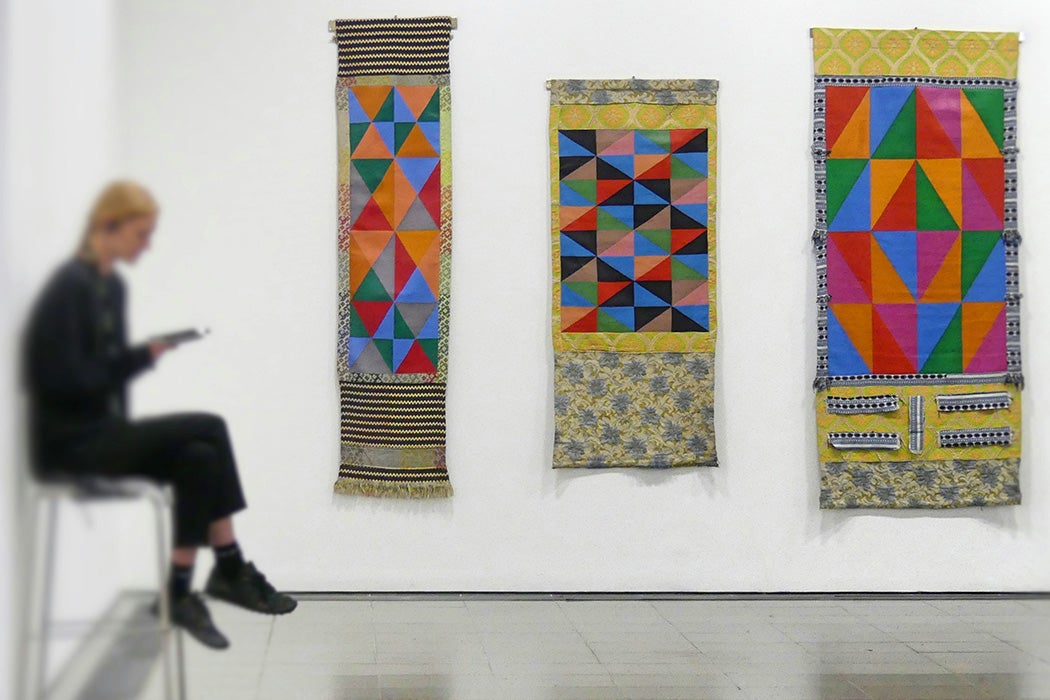Artist Faith Ringgold is known for her painted “story quilts.” Expanding upon the tradition of quilting, she adds large painted scenes to the central panel of her quilts and then surrounds these with narrative text panels. With these, she creates extensive series of quilts, strengthened by their seriality and a strong narrative that ties together each individual piece through a detailed plot line.
In her quilt series The French Collectio, 1991-1994, Ringgold uses this combination of painted images, narrative text, and decorative borders to explore the often absent role of African-American women in the art-world, particularly in Paris during the 1920s.
In a preface to an interview with Faith Ringgold, Melody Graulich and Mara Witzling introduce some of the roots of, and motivations behind, Ringgold’s desire to explore the art of the European masters in her distinct and unique way. After returning from a trip to Europe with her mother and daughters, Ringgold “began to try to find a way to create images of black people, technically by finding a way to render black skin tones, and thematically by producing portraits of members of her community, of ‘real’ black people, whose images had been absent in her formal art education. ‘Instead of looking to Greece, I looked to Africa.'”
In the first of twelve quilts comprising The French Collection, Ringgold opens the series showing Willia, the star of the quilts, with her friend Marcia and Marcia’s three little girls. The women dance in front of the Mona Lisa in the Louvre, forcing viewers to question the traditional conventions of museums. Rather than abiding by the typical respectful silence often assumed at museums, Ringgold shows the women defying such conventions in her fictive spaces, one where women are successful artists, and where African-American female voices are heard and respected. As Graulich and Witzling note, all “the narrators of Ringgold’s quilts are African-American women who speak with authority in their own voices.”
Surrounding the women with paintings by Raphael and Leonardo of idealized white women and serene images of motherhood, Ringgold immediately frames her black female characters in a traditionally white male space. Throughout this series and many other works, Ringgold focuses on the theme of African-American female displacement in the art world. By challenging not only the conventions of the museum, but also the exclusive art historical canon itself, Ringgold asks: Is there a natural setting for a female African-American artist?
In the Graulich and Witzling interview, they ask about what drew Ringgold to explore France in her works. She responds, “I was trained, very early, to copy French artists, Degas, Utrillo, Cezanne. Actually not so much Picasso and Matisse as the earlier ones. They were the masters that we were made to emulate. Those artists were in me, and I had to get that out. That can be very deadly, you know, that probably finished off a lot of people, not being able to get those artists out of their heads.”
Weekly Newsletter
In what appears to be a visual account of such an exorcism and reckoning for her character Willia, Ringgold creates Picasso’s Studio. Here, Ringgold positions Willia as both an artist and nude subject for Picasso’s renowned cubic masterpiece Les Demoiselles d’Avignon. Framed with the same floral borders and narrative text, Ringgold forces a multi-layered discussion between Willia, the women in the painting, and Picasso’s masks. A dynamic discussion physically surrounds the painting, as Willia describes hearing these voices while posing in the studio. Through this imagined conversation, Ringgold bombards the tight quarters of Picasso’s studio and the story quilt itself with questions about the root of primitivism in Western art and feminist reclamation and ownership of the female body.
As Willia lies in the typical odalisque position of passivity, Ringgold undermines this submissive position and negates it by giving Willia an active voice which reclaims the influence and beauty that inspired Picasso’s work: “It’s the African mask straight from African faces that I look at in Picasso’s studio and in his art. He has the power to deny what he doesn’t want to acknowledge. But art is the truth, not the artist. Doesn’t matter what he says about where it comes from. We see where, every time we look in the mirror.” Attributing Picasso’s work to the influence of the masks in his studio, Ringgold reclaims abstraction and Cubism as part of a much larger and historically deeper tradition with distinctly African roots.
Through this didactic retelling of history, Faith Ringgold uses her quilts to reframe the past, freeing absent and buried voices while offering new and stronger voices to future generations.







